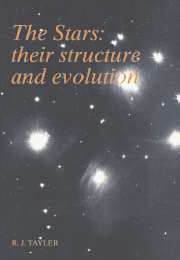Book contents
- Frontmatter
- Contents
- Preface
- Symbols
- Numerical values
- 1 Introduction
- 2 Observational properties of stars
- 3 The equations of stellar structure
- 4 The physics of stellar interiors
- 5 The structure of main sequence stars and pre-main-sequence evolution
- 6 Early post-main-sequence evolution and the ages of star clusters
- 7 Mass loss from stars
- 8 Close binary stars
- 9 Advanced evolutionary phases
- 10 The final stages of stellar evolution: white dwarfs, brown dwarfs, neutron stars and black holes
- 11 Concluding remarks
- Appendix 1 Thermodynamic equilibrium
- Appendix 2 The equation of radiative transfer
- Appendix 3 The pressure of a degenerate gas
- Suggestions for further reading
- Index
3 - The equations of stellar structure
Published online by Cambridge University Press: 05 June 2012
- Frontmatter
- Contents
- Preface
- Symbols
- Numerical values
- 1 Introduction
- 2 Observational properties of stars
- 3 The equations of stellar structure
- 4 The physics of stellar interiors
- 5 The structure of main sequence stars and pre-main-sequence evolution
- 6 Early post-main-sequence evolution and the ages of star clusters
- 7 Mass loss from stars
- 8 Close binary stars
- 9 Advanced evolutionary phases
- 10 The final stages of stellar evolution: white dwarfs, brown dwarfs, neutron stars and black holes
- 11 Concluding remarks
- Appendix 1 Thermodynamic equilibrium
- Appendix 2 The equation of radiative transfer
- Appendix 3 The pressure of a degenerate gas
- Suggestions for further reading
- Index
Summary
Introduction
In this chapter I consider what are the main physical processes which determine the structure of stars and what equations must be solved in order to find the details of this structure. At the outset it must be stressed that the theoretical astrophysicist does not usually attempt to calculate the properties of a particular star which has been observed. As we have learnt in the last chapter, the number of stars for which there is sufficiently detailed observational knowledge to make this procedure worthwhile is very small. Instead the theoretician tries to isolate the factors which mainly determine the properties of stars and then tries to calculate the structure of a wide range of possible stars. We shall see that the most important factors are the mass and initial chemical composition of the star and the time that has passed since it was formed. In what follows I shall often refer to the birth of a star, its age and its chemical composition at birth. Once calculations have been made for a range of values of mass, chemical composition and age, the results can be compared with the general properties of stars rather than with the properties of individual stars. I shall consider this comparison in Chapters 5 to 10. For one star, the Sun, we possess extremely detailed observational information and there has been a considerable effort to try to obtain a theoretical understanding of its properties.
- Type
- Chapter
- Information
- The StarsTheir Structure and Evolution, pp. 47 - 79Publisher: Cambridge University PressPrint publication year: 1994

